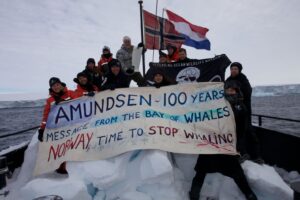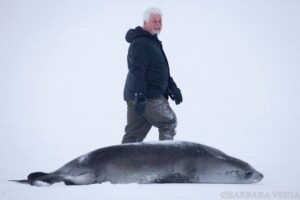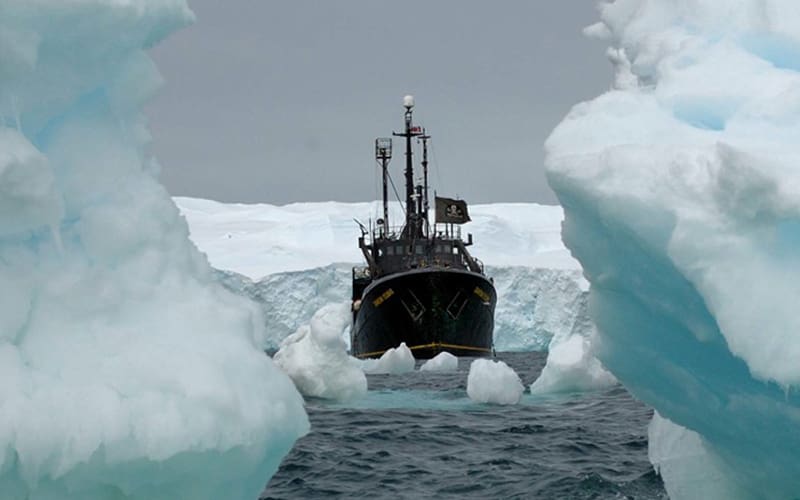Since first visiting Antarctica in 2002, I have led ten expeditions to Antarctica, all for the purpose of protecting and defending whales from the unlawful commercial operations of the Japanese whaling fleet.
In total I have spent some thirty-six months cruising back and forth along the coastline of the Antarctic continent from the Drake Passage westward to Mawson Station and then Eastward again, making brief stops at MacQuarrie, Heard and Kerguelen Islands and numerous islands of the South Pacific in Tonga, Pitcairn and Henderson, Vanuatu and Samoa.
Over eleven years I commanded eight different ships that transited the Strait of Magellan, the Suez and Panama Canals and operated out of the ports of Hobart, Melbourne, Sydney, Perth and Cape Town with numerous crossings of the Pacific, Atlantic, Indian and Southern Ocean through storms, icepacks and bureaucratic harassment. Most of the time was spent chasing and confronting Japanese whaling ships or disrupting Antarctic toothfish poaching operations but there were many opportunities to experience the incredible richness of wildlife in the Southern Ocean, on the ice and on shore.
On Christmas day, 2002 I had the pleasure of being a guest at the French Dumont d’Urville Station in Adélie Land where I was privileged to witness a fascinating sight. A large group of Emperors were walking slowly past the station towards the sea.
My crew and I were handed glasses of champagne by our French hosts as we stood and watched the baby penguins approach and stop abruptly at the ice edge which dropped two meters into the frigid sea.
It became a penguin pileup as it appeared that the penguins at the ice edge in front of the waddle were very reluctant to take the plunge.
They had never seen the sea before and suddenly there was no solid ice left to waddle across although their instincts were driving them forward. Still, it was a jump into the unknown and a cause for pause.
The penguins in front tried to walk backward but their brothers and sisters behind them oblivious of the drop into the blue, pushed back until one ungainly penguin stumbled and tumbled over the edge, ignobly splashing into the chilly sea.
Inspired or shocked the crowd of toddler penguins all plunged in comical unison into the sea. It was hilarious to watch them bob up and down and thrash about until they surprised themselves by realizing they were swimming.
Within minutes the walking waddle had become a swimming pack as they all headed seaward at the beginning of their nautical lives.
Over the next decade, I performed a marriage of two of my crew on the top of Scott Island in the Ross Sea and spread the ashes of my good friend and fellow Greenpeace Co-founder Robert Hunter across the flat expanse of a tabletop iceberg. Every year I dove into the sea to swim with the penguins and played dodgeball with automobile sized growlers while navigating through heaving ice floes. I loved every wondrous marvelous moment I spent in what was originally known in 1800 as Terra Australis and renamed Antarctica eighty years later.
Antarctica is to me simply the most spectacular and wondrous place on the planet and when descending south of Fifty, it is like crossing into an otherworldly dimension of floating mountains of resplendent shades of whites and blues.
The citizens of Antarctica from little Adelie penguins to Orcas, display an uncanny absence of fear. I had King Penguins march up to me while I was being interviewed on camera, curious to see what I was doing. I walked alongside a leopard seal as penguins teased him on the ice knowing he was a threat only in the sea. I stood on the edge of the Ross Ice Shelf, twenty meters high with an endless panorama of whiteness behind me, to the right and left of me, as I looked northward across the rolling blue of the Ross Sea and beyond to the Pacific knowing that there was not a scrap of land between me and the Arctic Ocean. As I stood there, one, two and then three Skua gulls began to land around me with patient hungry eyes probably wondering how a large mammal was standing on the edge of the Ross Ice Shelf with no visible means of survival. They looked quite miffed when my helicopter arrived to pluck me off the edge.
I think what attracts me to the southern continent more than anything else is the remote, isolated desolate expanse of frozen wilderness so placidly unspoiled and uncorrupted by the presence of human multitudes.
This is a place, the only place in this ravaged globe, not dominated, ruled and despoiled by the civilized insanity of humanity. It is the only place where I have felt connected to the real world, where the air is invigoratingly fresh where the creatures on land, in the sea and the air co-exist without fear or stress.
One day, a wandering albatross flew close by. From the bridge wing, I reached out my hand as its wing lightly brushed by leaving a single small feather between my fingers.
To me Antarctica is magic and mystery, alluring and captivating. I read Amundsen, Scott, Shackleton and Cherry-Garrard. I visited both Shackleton and Mawson’s huts and celebrated the 100th Anniversary of Amundsen’s successful trek to the pole at the Bay of Whales.
Constantly lurking behind the panoramic grandeur of Antarctica is a nagging uneasiness due to the ever-present awareness of remoteness,
extreme weather fluctuations, unpredictable ice conditions and the risks of engaging in high seas confrontations with large ships armed with angry men and deadly harpoons.
In the event of a mishap, there are few avenues of assistance. When the Norwegian sailing yacht Beserk issued a May Day in McMurdo Sound in February 2011, we pushed through extreme seas for twenty hours as the ocean congealed around us only to find the next morning a placid smooth and tranquil body of water that held no evidence of the raging tempest of the night before. All we found was a tattered raft and scattered packages of food. The yacht was in the frigid depths below us somewhere with three souls onboard.
For thousands of nautical miles, year after year, we pursued the huge Japanese whale factory ship Nisshin Maru and the fleet of four harpoon boats, pushing them onward, blocking their operations as we skirmished with the Japanese coast guard exchanging our stink bombs for their stun grenades and blasting each other with water cannons. Each time we passed a group of whales knowing they were safe as we kept the whale killers occupied was a jubilant day for us.
In the end, we saved some 6,500 whales, causing tens of millions of lost profits for the whalers until they quit, making me a very unpopular man in Japan.
What puzzles me about the Antarctic Treaty is that it plainly prohibits the exploitation of wildlife yet the Japanese whalers simply said they did not recognize it and even after we achieved a ruling from the International Court in the Hague underscoring their illegality, they continued to violently kill whales in blatant defiance of the International Court and the court of world opinion, while our interventions were labeled as eco-terrorism and violent although we did not harm a single whaler.
It saddens me to contemplate the future of Antarctica. The Antarctic Treaty implemented in 1959 is still in effect and has no expiry date but the continent sits at the bottom of the world like an enticing and alluring treasure chest filled with seductive riches that in a world of diminishing resources the temptation to exploit the continent for profit hangs over Antarctica like Damocles Sword.
If the Japanese whalers again return to the Southern Ocean, I will again return to stop them. It is the only thing that will force my return because as much as I cherish my time spent in the ultimate South, I need an ecologically good reason to do so if there is one thing that I have come to appreciate about Antarctica it is this: We don’t belong there and we should leave it untouched, certainly undeveloped and in peace.
|
|






